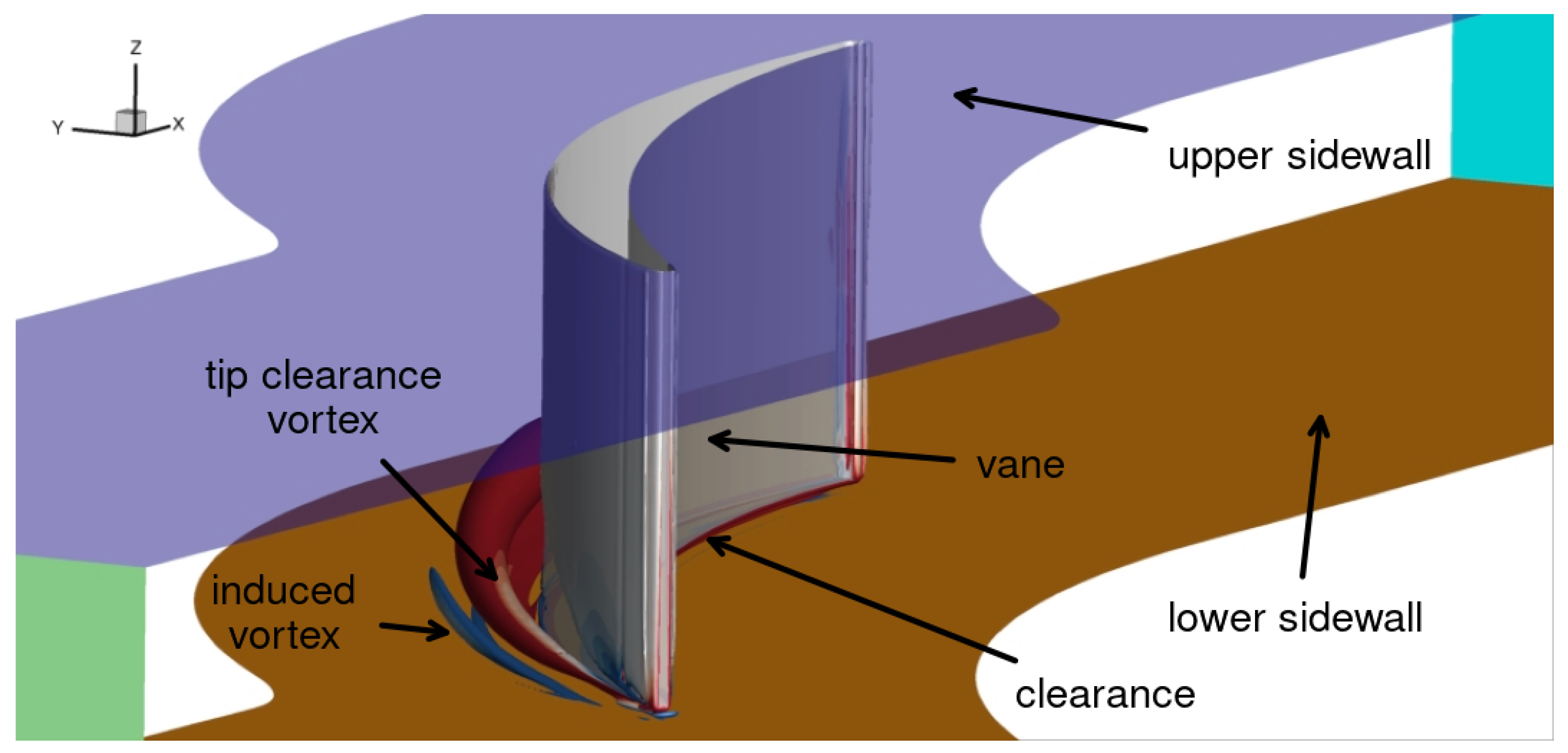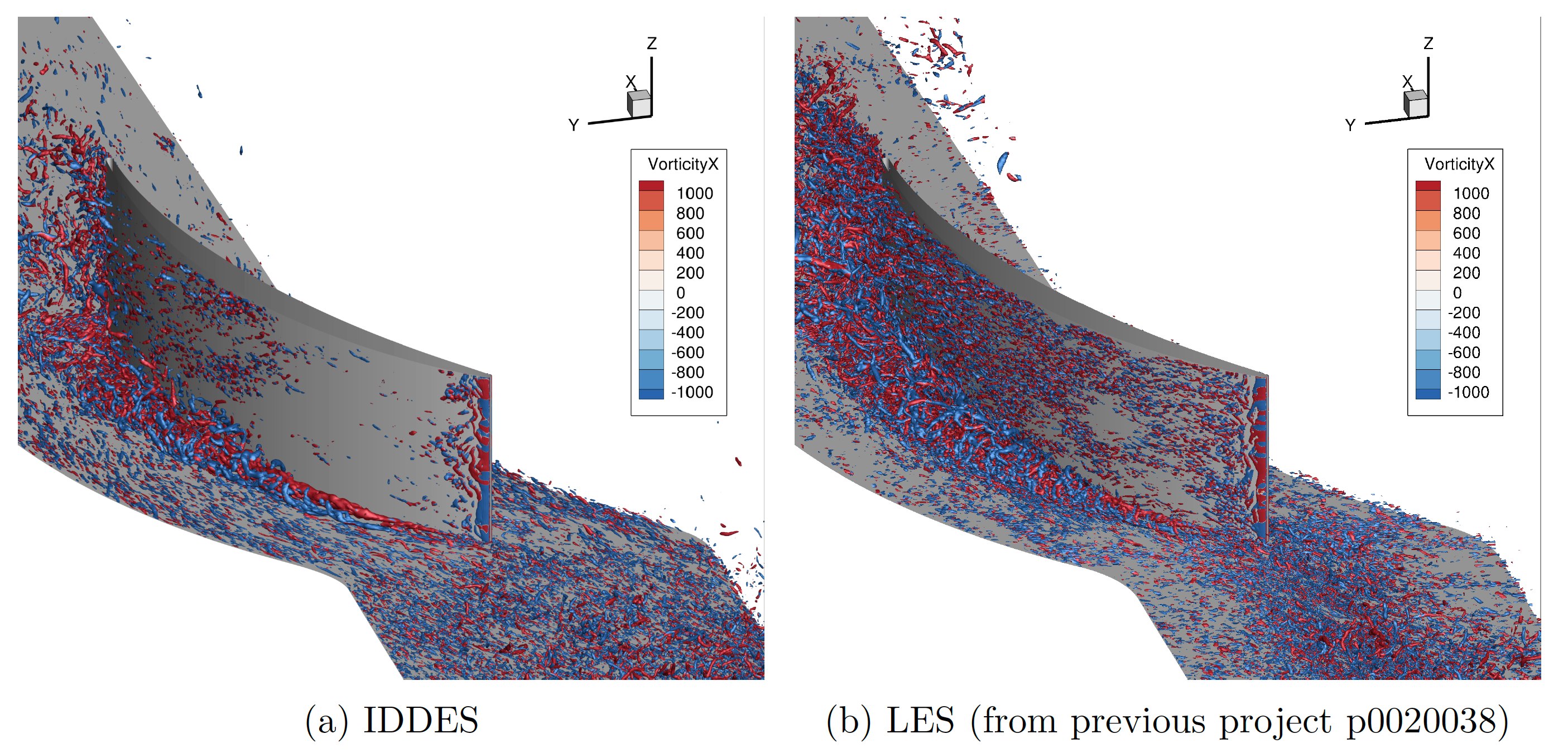Project
Investigation of the tip clearance of an axial compressor cascade using scale resolving simulations
In jet engines and gas turbines, a significant part of the loss generation is attributed to tip clearance flows in the compressor. The tools used in the design phase of turbomachines are mainly Reynolds averaged Navier-Stokes (RANS) simulations. These simulations compute a steady-state flow by modelling the influence of unsteady phenomena. This includes the interactions between the moving rotors and stators as well as the influence of turbulence on the flow field. However, RANS simulations lack the capability to model complex flow phenomena such as tip clearance flows accurately. High-fidelity flow simulations like direct numerical simulation (DNS) or large eddy simulation (LES) do not suffer from these shortcomings. Thus, they would b necessary to capture the flow physics in turbomachines correctly. However, they require enormous computational resources rendering them unfeasible for industrial applications. Thus, we investigated the capability of a hybrid RANS/LES modelling technique that requires less resources to resolve a tip clearance flow correctly.
Project Details
Project term
July 6, 2023–August 27, 2024
Affiliations
RWTH Aachen University
Institute
Institute of Jet Propulsion and Turbomachinery
Project Manager
Principal Investigator
Methods
We applied a turbulence modelling approach called Improved Delayed Detached Eddy Simulation (IDDES) to simulate a compressor cascade with a clearance at one sidewall. The simulation domain is shown in Figure 1. The IDDES approach intends to model the turbulence in attached boundary layers, while resolving turbulence in detached flows. In a previous investigation, we used the aforementioned high-fidelity method, a wall resolved LES, to simulate the same test case enabling a fair comparison between both simulation results.
Results
The boundary layer thickness is one of the key drivers that influence the tip clearance vortex. Thus, we performed several initial studies in order to ensure a similar boundary layer upstream of the cascade. After achieving a satisfactory agreement between LES and IDDES in the inflow region, we ran the full simulation of the flow domain and collected all necessary data using a sampling interval of 12 convective throughflows of the compressor cascade. The vortex structure of the tip clearance flow is shown for LES and IDDES in Figure 2. The vortex structure differs significantly between the simulation methods. The IDDES results (Figure 2a) indicate a strong induced vortex (shown in blue close to the tip clearance). This vortex does not occur for the reference LES (Figure 2b) as it is quickly mixed out. This difference in the vortex structure effects the direction of the tip clearance flow significantly, shifting the position of the vortex core by about 10% axial chord in the pitchwise direction. The fluid of the induced vortex in the IDDES simulations stems from the sidewall. Since the sidewall boundary layer is attached, its turbulent content is mostly modelled. As soon as the vortex separates from the boundary layer, the modelled turbulence is suddenly reduced leaving the induced vortex in a laminar state. The resolved turbulence starts to
form only after a significant development length.
Discussion
The results indicate the necessity for further improvements in the context of IDDES, particularly at the interface of modelled to resolved turbulence. An optimal outcome for the current test case might be achieved by fully resolving the boundary layer on the lower sidewall, while modelling the boundary layer on the vane surface. With respect to the use of IDDES in turbomachinery, further studies are necessary as the current test case does not contain a relative motion between the sidewall and the vane. Moreover, the effects of Reynolds number variations needs to be studied in order to evaluate the accuracy of IDDES for particular turbomachinery applications.
Additional Project Information
DFG classification: 404-04 Hydraulic and Turbo Engines and Piston Engines, 404-03 Fluid Mechanics
Software: TRACE
Cluster: CLAIX
Publications
Deutsch, J.; Fard Afshar, N.; Henninger, S. and Jeschke, P.:
A comparison of Reynoldsaveraged Navier-Stokes and scale resolving simulation methods for a tip clearance flow of a linear compressor cascade, Proceedings of Direct and Large Eddy Simulation 14, review pending and to be published in 2025
 Figure 1: Investigated test case with tip clearance vortex
Figure 1: Investigated test case with tip clearance vortex  Figure 2: Vortex structure for tip clearance flows of the investigated compressor cascade
Figure 2: Vortex structure for tip clearance flows of the investigated compressor cascade